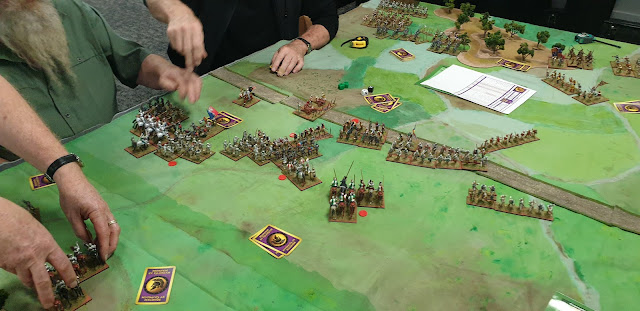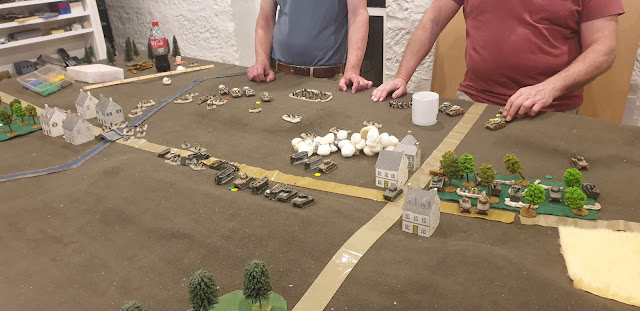Liebertwolkwitz was a prelude to Leipzig. Murat was ordered to cover Bonapart's southern flank while the main French army deployed. Wurtemburg was ordered to advance on Leipzig with a mixed force of mainly Russians & Austrians plus a few Prussians.
SteveD set the battle up with his 15mm figs on a 10"x6' table fought with Camp Cromwell rules.
The French started in two lines of corps. The front line of infantry centre & left. They second line is mostly cavalry centre & right. Poniatowski's corps is coming up behind the French right & Laurston's corps is coming up behind the French left.
The Allies have Austrian infantry on their right, Russian infantry in their centre & a mixed force of cavalry on their left. They have more troops coming up behind both flanks.
Both sides spend some time sorting themselves out into fighting formations.
The French take up a defensive line on the chain of ridges.
The Allies advance their infantry & artillery on their right & centre.
The French are concentrating their cavalry on their right.
The Austrian corps on the right is advancing in a mix of line & column while a reserve corps comes on behind them.
The Russian corps in the centre deploys into line behind their numerous artillery which begins to bombard the French on the ridge.
The Allied cavalry on the left has deployed defensively with both flanks covered by infantry & artillery to provide crossfire on any French attack.
On the far flank Poniatowski's corps is advancing on the infantry deployed in the woods & the French cavalry has advanced to just outside artillery range.
In the centre the artillery duel continues with the sheer number of Russians guns giving them an advantage.
On the right the Austrian infantry has engaged the French left which is hard pressed against superior numbers though Lauriston has now come on in support.
Laurenson's arrival behind the French left is too little too late as the mass of Austrian infantry, cavalry & artillery break the French first line on that flank.
In the centre Russian infantry has deployed into columns & advanced past their batteries towards the French lines which have been softened up by bombardment.
Some French cavalry has been detached from their right flank & is being sent to support their crumbling left flank. The Allied cavalry then advanced within charge range of the remaining French cavalry.
On the far flank Poniatowski is being bogged down in the woods.
On the right Lauriston is being overwhelmed by Austrian infantry & artillery. Austrian cavalry has broken through on the right of the village & met the French cavalry from the far flank behind the French centre.
In the centre, the French infantry held off the attack close to the far village, but on the main ridge their outnumbered & shot up line has been shattered.
On the far flank the French cavalry have finally charged the Allied cavalry.
On the right Lauriston is on the verge of breaking.
In the centre, Austrian infantry have broken through & hit the French cavalry engaged with the Austrian cavalry in flank ending any hope of the cavalry saving the day.
On the left the French had lost their numerical superiority on the flank when they detached a division to support their left & both sides have won & lost units in indecisive mutual destruction.
At this stage the French have lost all hope of holding the position & so ordered a withdrawal. They had held on for 17 turns so although the Allies have clearly won the battle, Murat could argue that he had delayed the allies for long enough to achieve what Bonapart had asked of him.





















































